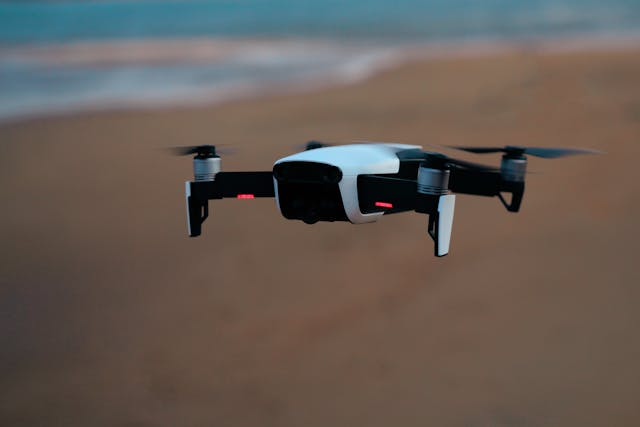Urban Air Mobility (UAM) represents a future where air transportation systems operate within and around urban areas, offering a new dimension to city commuting and logistics. Software tools that allow testing and monitoring of UAM are key factors in the successful development of this technology. This innovative mode of transportation leverages advanced aerospace technologies, electric or hybrid propulsion systems, and autonomous flight capabilities to move people and goods efficiently above congested city streets. As we grapple with growing urban populations and the limitations of traditional ground-based transport, UAM emerges as a promising solution to reduce traffic congestion, enhance mobility, and contribute to a more sustainable urban ecosystem. With its potential to redefine urban transportation, urban air mobility is at the forefront of creating intelligent, interconnected cities of the future.
Unmanned Traffic Management (UTM) Software
Definition and Role of UTM
Unmanned Traffic Management (UTM) systems are specialized software frameworks that facilitate safe and efficient airspace operations involving unmanned aircraft systems. As the skies get busier with drones and other autonomous vehicles, UTM is crucial in managing this new form of traffic, ensuring that air mobility remains a solution rather than a hazard.
Critical Features of UTM
UTM systems offer several key functionalities, including:
- Route Planning: Ensures optimal paths for each aerial vehicle in compliance with prevailing regulations and environmental conditions.
- Collision Avoidance: Integrates with sensors and communication systems to prevent in-air mishaps.
- Real-Time Monitoring: Allows for continuous tracking of all aerial traffic within a given airspace.
- Airspace Compliance: Ensures all operations meet local and international airspace regulations.
Popular UTM Platforms
Several platforms have emerged, including Altitude Angel and AirMap. Many UAM providers favour these platforms for their robust feature sets and reliability in keeping urban skies safe.

Simulation and Testing Platforms
Simulation and testing are critical to developing urban air mobility (UAM) systems. This process involves using sophisticated software and physical trials to model UAM vehicles and their behaviour under various conditions. The goals of simulation and testing in UAM include verifying the vehicles’ safety, efficiency, and reliability and ensuring that they comply with stringent regulatory standards.
The simulation uses advanced computer models to replicate the UAM environment, including air traffic, weather conditions, and urban landscapes. Virtual simulations enable engineers to:
- Analyze Aerodynamics: Test how UAM vehicles interact with air flows and physical forces during flight.
- Optimize Design: Iterate vehicle designs before creating physical prototypes, saving time and resources.
- Pilot Training: Develop robust training programs for pilots using realistic flight simulators.
- Air Traffic Management: Explore how UAM vehicles can be integrated into existing airspace with minimal disruption.
- Safety Protocols: Validate emergency procedures and system redundancies in a virtual context.
Testing transitions from virtual environments to controlled, real-world scenarios. This includes:
- Wind Tunnel Testing: Assesses the aerodynamics of scale models or full-size vehicles in a controlled airflow.
- Flight Testing: Involves test pilots and autonomous systems piloting UAM vehicles under supervised conditions.
- System Testing: Focuses on the reliability of avionics, propulsion systems, and flight control software.
- Integration Testing: Ensures that different subsystems (e.g., sensors, communications, and navigation) operate seamlessly.
Predictive Maintenance and Monitoring Software
Predictive Maintenance (PM) is a proactive strategy crucial to the long-term operational sustainability of UAM fleets. Using data analytics, machine learning, and Internet of Things (IoT) technology, predictive maintenance anticipates when maintenance should be performed on UAM vehicles. This helps prevent unexpected breakdowns and reduces the time vehicles are out of service.
Here are several ways PM can benefit UAM:
- Enhanced Safety: By continuously monitoring the health of UAM vehicles, operators can address potential issues before they lead to system failures.
- Operational Efficiency: Scheduling maintenance based on actual vehicle needs rather than predefined intervals optimizes resource use and maximizes vehicle availability.
- Cost Savings: Predictive maintenance can identify wear and minor issues before they become major problems, resulting in lower repair costs and extended vehicle lifespan.
- Data-Driven Insights: Collecting and analyzing data from numerous sensors throughout the vehicle can provide insights into design improvements and operational best practices.
Implementing predictive maintenance involves several key facets:
- Sensor Implementation: Embedding sensors in critical components of UAM vehicles to collect data on performance and wear.
- Data Aggregation: Compiling data in a centralized system for analysis, which includes historical maintenance records and real-time operational data.
- Advanced Analytics: Leveraging algorithms and machine learning to identify patterns and predict which components require maintenance.
- Maintenance Scheduling: Using analytics outcomes to schedule maintenance more effectively, with minimal disruption to service.
Predictive maintenance transforms UAM operations from reactive to proactive, ensuring a safer and more dependable urban air transport environment.
Compliance and Regulatory Management Software
Importance of Regulatory Compliance in UAM
Due to UAM’s novel nature, adherence to stringent regulatory standards is essential. This ensures safety, public trust, and the viability of UAM enterprises in crowded urban environments.
Key Features of Compliance Software
Compliance management systems for UAM should facilitate the following:
- Regulatory Data Management: Keeps up-to-date with ever-changing aviation laws and regulations.
- Automated Compliance Reporting: Streamlines the process of documenting compliance with aviation authorities.
- Audit Trail Capabilities: Provides transparent records needed for regulatory reviews and certifications.
Examples of Compliance Management Tools
Tools like Comply365 and MetricStream offer robust solutions tailored to highly regulated industries like UAM, ensuring companies can manage compliance efficiently.
Conclusion
As Urban Air Mobility continues to evolve into a key player in urban transit ecosystems, adopting the right software tools cannot be overstated. Companies venturing into this promising field must have the best-in-class UTM, simulation, predictive maintenance, and compliance management software to ensure viable solutions.
The horizon of technological advancements promises even more sophisticated tools that will further refine, secure, and streamline UAM initiatives. For developers and UAM companies, staying informed and agile when adopting these tools will be vital in shaping the future of urban transportation.


I truly appreciate your technique of writing a blog. I added it to my bookmark site list and will